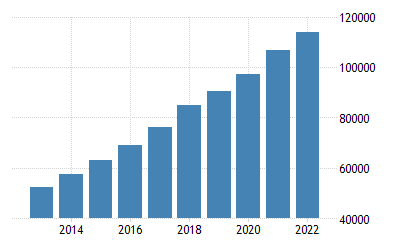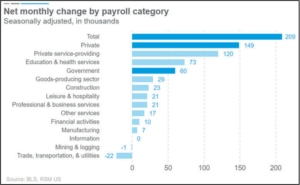What Does the Fitch Downgrade Mean for the Global Economy?
Fitch downgraded the US credit standing from AAA to AA+. This has led to unexpected market volatility and could be one of the larger, unexpected financial events of the year. Although this still must be taken in context (relative to other markets and whether they will also be downgraded), this is a blow to the Biden Administration and the US Government.
First, there are multiple rating agencies, and it is important to continue to watch how others react. One must consider that the impact could be minimal after the initial market reaction, especially if Fitch ends up being one of the few to act this way. The other factor is that the US does not operate in a vacuum; investors are looking at risk across many markets, and sometimes, even if the US is a bit riskier than it was a few days ago, it is still one of the more attractive places to put investment dollars. But it wasn’t long ago (2011) that the world thought a downgrade of US credit was the end of the world and the global economic environment would collapse.
Second, economists are mixed on what this means. Most are stunned by the move and believe it is not warranted, and some even suggested that it might be politically motivated. This has become a hotly contested political issue. If you are on one side of the political equation, this is devastating news and a sign that the country is in a tailspin. If you are on the other side, you think Fitch was just flat wrong. The truth is probably somewhere down the middle.
Here is what Fitch said led to the downgrade:
- Expected fiscal deterioration over the next three years. Fitch projects that the US government’s debt-to-GDP ratio will rise to 108% by 2025 from 102% in 2022. This increase is driven by a combination of factors, including rising interest rates, slower economic growth, and increased spending on social programs.
- A high and growing general government debt burden. The US government’s debt is already the highest among all developed countries, and it is expected to grow. This high debt burden could make it more difficult for the government to respond to future economic shocks.
- Erosion of governance relative to ‘AA’ and ‘AAA’ rated peers over the last two decades. Fitch has observed a steady deterioration in standards of governance in the US over the past 20 years, including fiscal and debt matters, manifested in repeated debt limit standoffs and last-minute resolutions.
With the US now out of the mix (at least from Fitch’s perspective), there are only 10 remaining AAA credit ratings in the world.
- Australia
- Austria
- Canada
- Denmark
- Finland
- France
- Germany
- Japan
- Luxembourg
- Singapore
The Fitch downgrade of the US to AA+ from AAA could have a number of negative consequences, including:
- Higher borrowing costs. The downgrade will make it more expensive for the US government to borrow money, as investors will demand a higher risk premium. This could lead to higher interest rates on US Treasuries, which would make it more expensive for businesses and consumers to borrow money.
- Reduced investor confidence in the US economy. The downgrade could also reduce confidence in the US economy, as investors may view it as less stable and less likely to repay its debts. This could lead to a decline in the value of the US dollar and a slowdown in economic growth.
- Increased political uncertainty. The downgrade could also increase political uncertainty, as it could lead to a loss of confidence in the government’s ability to manage the economy. This could make it more difficult for the government to pass legislation and could lead to gridlock in Washington.
- Increased risk of a sovereign debt crisis. If the downgrade leads to a sharp increase in borrowing costs, the US government could face difficulty meeting its debt obligations. This could lead to a sovereign debt crisis, which would have a devastating impact on the US economy.
- Damage to the US reputation. The downgrade could damage the US reputation as a safe haven for investors. This could lead to a decline in foreign investment in the US, which would have a negative impact on the economy.
The downgrade could impact investors such as:
- Governments. Governments often require a AAA rating for investments because they need to be able to borrow money at low interest rates. This is because a AAA rating indicates that the government is very likely to repay its debts.
- Financial institutions. Financial institutions, such as banks and insurance companies, also often require a AAA rating for investments. This is because they need to be able to maintain their financial stability. AAA rating indicates that the investment is very unlikely to default.
- Large corporations. Some large corporations also require a AAA rating for investments. They need to be able to attract investors and maintain their credit rating. AAA rating indicates that the corporation is very unlikely to default on its debts.
- Pensions. Some pensions require a certain percentage of their investments to be AAA rated.
This is a wait-and-see situation. Without at least one of the other large credit rating agencies following suit, this may land with a thud after the initial reaction.
The Threat to Chinese Manufacturing
The last few years have witnessed a great deal of change when examining the global trading system. There has not been one single development that can shoulder all the blame, but it is clear the pandemic was a key motivator. Add in the increased political tension between the US and China, the inevitable consolidation of industry despite and often because of globalization, as well as the more recent development of recession and inflation, one sees some extremely disrupting economic trends. China is getting caught in these shifts and has some difficult choices to make. For four straight months, the manufacturing sector has been tracking in contraction territory according to the Purchasing Managers’ Index. The readings are not deep in the 40s, but after nearly a decade of consistent growth, the decline has been worrying.
The reasons for the deterioration are not hard to determine, but the response of the government has been unpredictable.  There is a contradiction built into the proposed strategies. The reality is that China is an economy that has been built on exports and on the massive levels of western investment designed to support the shift to China as a global manufacturing center. It was the key to the amazing double-digit growth of the past twenty or thirty years. This is what propelled China to its number two status in global economies. Politically this was a problem, however. China was dependent on the western markets that bought this output and even more dependent on western investments. This hampered the Chinese leadership when it came to confronting the US or Europe or even Japan. The current set of tensions illustrates the issue. China’s efforts to pressure Taiwan, militarize the South China Sea, support Russia’s invasion of Ukraine, support North Korea, and a host of other initiatives serve to frustrate the US. The response has been to impose tariffs and other restrictions and that provoke the Chinese to respond in kind. The aim of Xi Jinping from the start of his tenure has been to shift China to an economy driven by its own consumers and not by the consumers of China’s exports. This is easier said than done.
There is a contradiction built into the proposed strategies. The reality is that China is an economy that has been built on exports and on the massive levels of western investment designed to support the shift to China as a global manufacturing center. It was the key to the amazing double-digit growth of the past twenty or thirty years. This is what propelled China to its number two status in global economies. Politically this was a problem, however. China was dependent on the western markets that bought this output and even more dependent on western investments. This hampered the Chinese leadership when it came to confronting the US or Europe or even Japan. The current set of tensions illustrates the issue. China’s efforts to pressure Taiwan, militarize the South China Sea, support Russia’s invasion of Ukraine, support North Korea, and a host of other initiatives serve to frustrate the US. The response has been to impose tariffs and other restrictions and that provoke the Chinese to respond in kind. The aim of Xi Jinping from the start of his tenure has been to shift China to an economy driven by its own consumers and not by the consumers of China’s exports. This is easier said than done.
Chinese manufacturing is aimed at the western states not the domestic population. The Chinese may have a “middle class” of 400 million people, but this is not the middle class of the US. The average size of a Chinese house is 500 square feet, and the average in the US is 2,000 square feet. The US consumer can accumulate a great deal more than a Chinese consumer can. There are also stark differences between these populations when it comes to saving and spending. The US is a consumer-driven population while Chinese save. The US personal savings rate is now at about 4.5% and is among the lowest in the world. The average savings rate in China is 38%. This is not a population that chooses to consume, and that means that manufacturers in China have to look elsewhere for demand. There have been efforts to stimulate consumer spending in China with higher salaries and wages. The increase in major cities has been well over 1,000%. This has made China more expensive as a production platform but has not yielded a strong consumer base.
China is not in a position to pull significantly away from its export-centric economy, and that means dependency continues. The US is also dependent on China in the sense that it buys those Chinese exports, but it is easier to find replacement suppliers than it is to find replacement consumers. The US is turning to rival nations such as Vietnam, India, Mexico, and others – all eager to capture the business that China is losing. Who else can China send its output to? Is there any nation that consumes as much as the US? The answer is clear: There are no alternatives to the buyer in the US – not the domestic consumer in China and not the consumer in any other part of the world.

